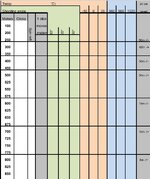THLR
WKR
- Joined
- Mar 6, 2020
- Messages
- 322
Next episode. Sorry, this is not a very entertaining film and I'm going the long way in this season...
Very basic.
Very basic.
Follow along with the video below to see how to install our site as a web app on your home screen.
Note: This feature may not be available in some browsers.
Thomas - we come to you for knowledge, not entertainment.Next episode. Sorry, this is not a very entertaining film and I'm going the long way in this season...
Very basic.
Loved both of these videos.Here's the next episode, more on the same basic themes
Yes you deducted correctly.Loved both of these videos.
Can you explain why you left your zero to the left (1-2cm) on your 100m target? I know you said "spindrift" and the shots where it's close enough to see that you are "off" it probably doesn't matter on animals or large targets. Is this just personal preference so that at the 600m and longer targets you're not having to include spindrift in your "wind hold"?
Thanks! and again, great content!
Thanks!Yes you deducted correctly.
It is my personal preference.
I'd rather take have the error where it's small enough to be irrelevant and have a more "neutral" windhold meaning rather than forget the correction and have that be the difference between a marginal lung shot and a burst diaphrame with poo salsa pushed into the meat.
I doubt it is important enough to really matter.
Totally agree on visual observation under 10 mph and on trying not to get too gear focused. As for the cultural anffinities, I’m a Mil guy because tenths are easier than quarters. But wind speeds in meters per second and metric barometric pressure just makes my brain hurt. I’ve started using the Quick Drop approach that Form recommends over the last year or two and like it a lot. His Form Fridays are part of the Shoot2Hunt podcast that is on their website, Apple Podcasts, YouTube and others. Here are a couple that are pertinent to quick drop and wind brackets.They are not specific to my environment, as I've applied them on several continents.
You can extrapolate from lower windobservations, but then you have to know what the Hellmann Coefficient is (a formula for "friction" in the terrain) or apply "firefighter's math". Both which would be wildly inconvenient methods compared to raising a Kestrel. The mentioned Beaufort scale is in my opinion rubbish for a shooter.
Visual observation is best limited to velocities not higher than 10 mph. Beyond that you start having so much whipping - vibration - boiling as well as mechanical turbulence over terrain features which will give you false readings.
My opinion is that you should get your windcall down to 2mph error or less. More than that and you run out of range/ error budget pretty fast. My opinion is that you should be familiar with your error budget and the shoot/no shoot decision should be a gauging of budget against available target surface.
Under the conditions you subscribe, I certainly cannot do that without a Kestrel. I have headshot at 400-450'ish under similar conditions (the shot needed taking to fix someone elses problem), but that was with high Bc bullet (g1 up towards 0,8?) AND the wind observation was held against earlier Kestrel measurements. So it was a comparison of two pictures and not an actual windobservation taken "off the terrain". It was "this looks the same as the last spot which measured 9 msec (18'ish mph)". Even so, it was a lucky shot. I would not have been able to detect an 8 or 11 or even react to a gust (which is a sudden increase 5 msec or more)
...just in case ther's been a misunderstanding, "half the hundreds" is windage, not drop/elevation if that was the reference. It is in essense the same as the mph gun system, it's just a convenient way to arrange the numbers. Allthough the unit names and process might have variations, the physics behind remains the same. If the efficiency is there, no protests from my side - it's easy to develop a "cultural affinity" for certain units of measurements (for example naming the wind knots, mph, msec or kmh - they all do the same thing under different names). So I doubt there would be much difference between us as understand both of us to be oriented towards killing. I suspect Form is a bit more updated as I essentially stopped evolving sometime around 2010-12, and I've also stepped "back and down" since my 2021 haircut. Limited time and resources, so I focus on an even smaller skillset.
Do you have a link to the podcast? Searching Form Friday on Spotify gave me the episode "who killed Jesus". I have an inkling there's little shooting involved in that podcast...
Was this helpful or perhaps just a wall of text?
Edit:
And just to be clear: I have nothing against Kestrels.
I'm just trying to keep the material threshold (and monetary investment) lower for a beginning shooter.
If you understand basic wind and pick up a Kestrel, you have a gain.
If you never learnt basic wind and just take a number of a Kestrel, you have a handicap and a training error.
I suspect that when the reality of field shooting kicks in, many will find the simple methods to be "sufficient for effective range" until getting into position is mastered. Recognizing and getting TO a position where you can take the shot is THE prerequisite for a good shot. Why juggle gear? Your eyes should be on target, your head should be on the environment and you should be "present" enough to understand what is happening right now.
I haven't seen Anna lately, but Elsa is still in the neighbourhood. She usually drops by for the season's greetings. Haven't seen her that much recent years though, she's a grown woman now and have to prioritize differentlyI also had to start out by telling them you probably lived close to Anna and Elsa(Disney Princesses).
Gotta start them young!

I have listened now, seems to be no significant differences really. Vocabulary/ choice of names more than anything.Have you to listened to his recent Form Friday podcasts on that? Do you see any significant differences between what would are doing for windage and elevation from what he is using?
I appreciate your responses. It’s always nice to get a little cross pollination on ideas.I have listened now, seems to be no significant differences really. Vocabulary/ choice of names more than anything.
What I call "dead rifles" is covered in the rifle setup podcast, only point I'd add is also to consider the trigger housing. An "open" trigger (interior exposed) like Jewell can be a nightmare in snow (and likely dust), whereas a "closed" trigger (interior capsuled) like Triggertech just seems to be a better idea.
MOA vs MILS isn't really a discussion here; if you are not using MILS you are doing it wrong and there are no MOA users that needs converting.
Ballistic solutions for the field, we both organize the numbers for speed and simplicity. The trajectory table screenshot/screensaver was clever; I try not to bring a cellphone simply because I don't want to be available (in recent years, com requirement has forced me). I have perhaps reduced trajctory data from full DA capacity down to a window of 30° C degrees and 3000m altitude variation and I have it all right on the rifle vs a trajectory card but both methods has the same resolution so it's more how preferences has evolved.
His numbers on accuracy fits very well with what I've seen and my own performance, if you do the math on my targets I reckon you end up with the same numbers.

